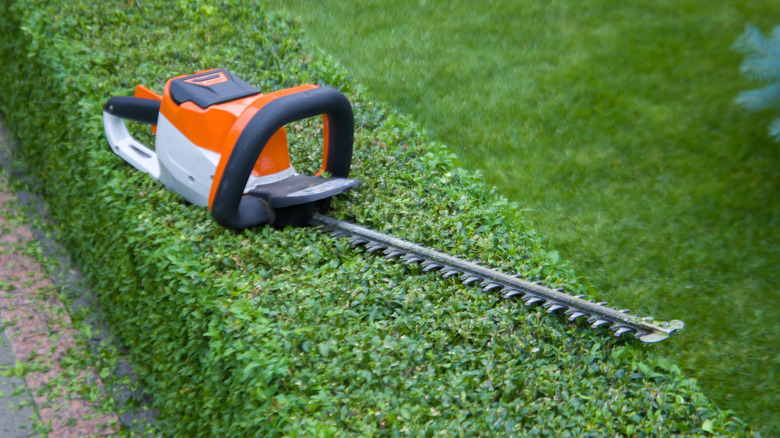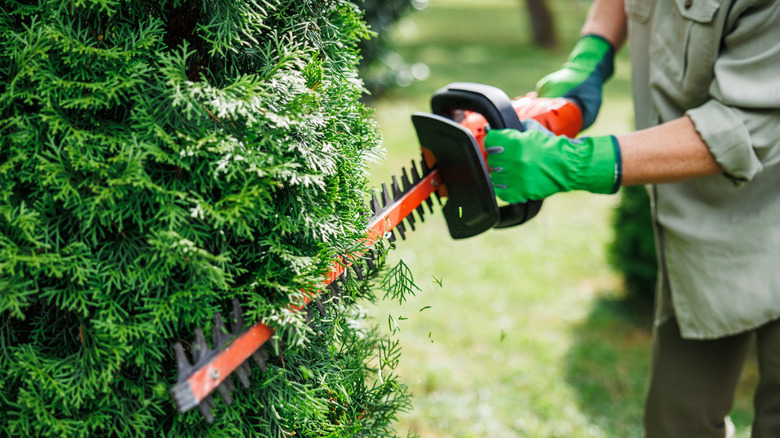Hedge Trimmers Vs Cutter: How To Determine The Best Tool For Your Needs
Maintaining pristine, sculpted hedges is a hallmark of a well-kept yard — they add privacy, structure, and big curb appeal to any property. However, the path to getting those perfect line cuts can be confusing, mostly thanks to a fundamental question: which tool is right for the job? Though many folks say "hedge trimmer" and "hedge cutter" interchangeably, professional landscapers get that these are technically two different instruments, each engineered for a specific task in making your hedges look great. And it's important to understand the differences between the two before you get started.
A traditional hedge trimmer is the more common tool used in homes, as it is primarily designed for finesse and frequent maintenance. This lightweight tool features smaller, finer blades with closely-set teeth, making them ideal for snipping through new growth, small twigs, and soft stems. Using simple ways to keep trimmers in tip-top shape in between jobs makes hedge upkeep easier. On the other hand, when the job demands more sheer force than artistry, the heavy-duty hedge cutter comes into play. These machines boast longer, thicker blades and are built to sever broader branches that a trimmer just can't; if the branches are too thick, you may need a chainsaw, however.
Think of the difference not as better versus worse but as a specialized division of labor. One tool is the scalpel of the landscaping world, while the other is the machete. Both are handy to have, along with the other most essential gardening tools. Figuring out which one is right for your needs depends entirely on the size and density of your hedges and how tidy they currently are.
Sculpting, finishing, and the right tool for the job
The core difference between hedge trimmers and cutters is their cutting capacity. The hedge cutter has a powerful motor and a wider, heavy-duty blade set, and it is defined by its brute power. It's the tool that's often needed for initial hedge work, especially if the hedges have been ignored for a while. So, the cutter handles the initial passes for taming overgrown hedges. When tackling woody material or thicker branches, a cutter's wide tooth gap and capable engine let it slice through dense foliage without jamming. This raw strength makes it easy to lay the groundwork for shaping a huge, unruly hedge where branches need to be removed quickly and aggressively before the fine details can be considered.
Conversely, the trimmer is exactly what's needed for precision sculpting. This tool's lighter weight and close-spaced, fast-moving blades are all you need for smaller stems, like those under a half-inch thick. Once a cutter establishes the outline of the hedge and reduces it to a manageable shape, the trimmer then steps in to fine-tune things. Here, it levels the tops, smooths the sides, and creates that lovely sharp edge that elevates a hedge from a functional boundary to a garden feature.
Pro landscapers typically use both tools together: the cutter to drastically remove any excess, then the trimmer for that detailed, photographic finish. As for homeowners, if your hedges are mature, dense, as-of-yet unsculpted, or require heavy annual pruning, lean toward the higher capacity of a cutter. And if your hedges are still young or only need routine tidy-ups, the maneuverability and lighter touch of a trimmer is much better for focused touch-up jobs. Either will make your yard look great and fit right in with other tools that'll take care of most yard problems.

